Abstract
We examined the hypothesis that respiratory sinus arrhythmia (RSA) is primarily a central phenomenon and thus that RSA is directly correlated with respiratory controller output. RSA was measured in nine anesthetized dogs, first during spontaneous breathing (SB) and then during constant flow ventilation (CFV), a technique whereby phasic chest wall movements and thoracic pressure swings are eliminated. Measurements of the heart rate and of the moving time averaged (MTA) phrenic neurogram during these two ventilatory modes were made during progressive hypercapnia and progressive hypoxia. RSA divided by the MTA phrenic amplitude (RSAa) showed a power-law relationship with both arterial carbon dioxide partial pressure (PaCO2) and oxygen saturation (SaO2), but with different exponents for different conditions. However, the power-law relation between RSAa and respiratory frequency had an exponent indistinguishable from -2 whether hypoxia or hypercapnia was the stimulus for increased respiratory drive, and during both CFV and spontaneous breathing (-1.9 +/- 0.4, hypoxia, SB; -1.8 +/- 0.7, hypoxia, CFV; -2.1 +/- 0.8, hypercapnia, SB; -1.9 +/- 0.7, hypercapnia, CFV). We conclude that respiratory sinus arrhythmia is centrally mediated and directly related to respiratory drive, and that changes in blood gases and phasic afferent signals affect RSA primarily by influencing respiratory drive.
Full text
PDF
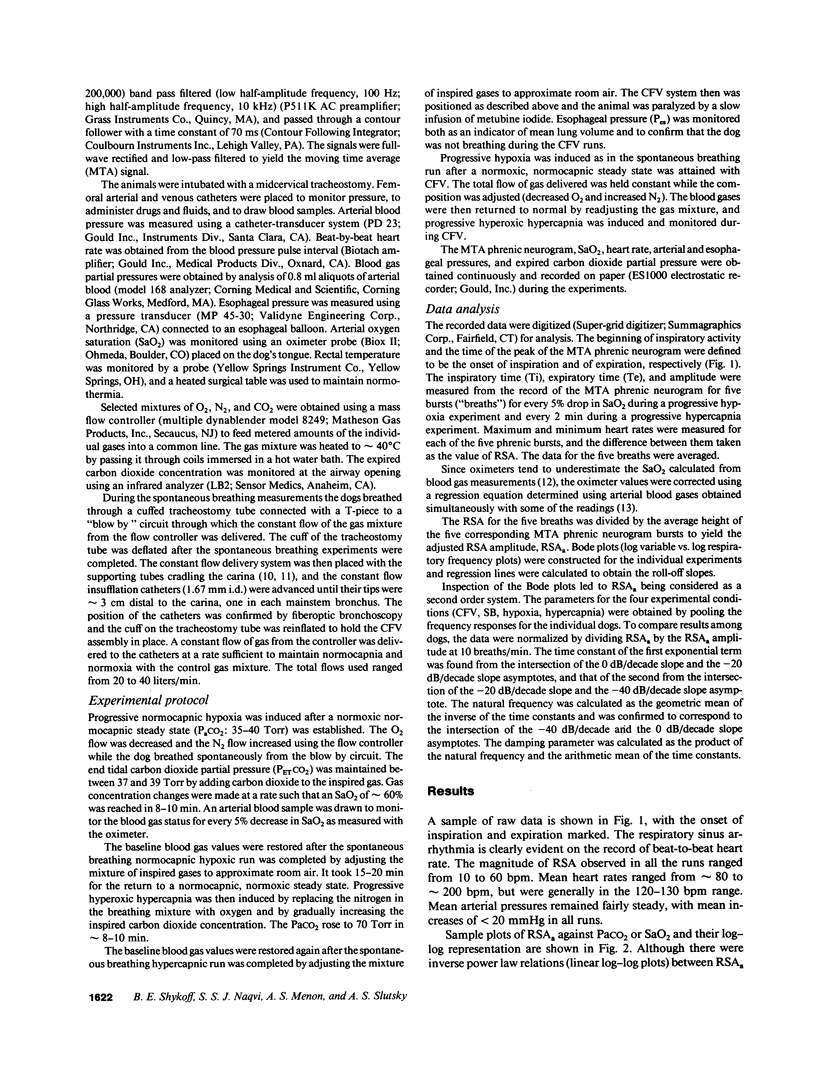
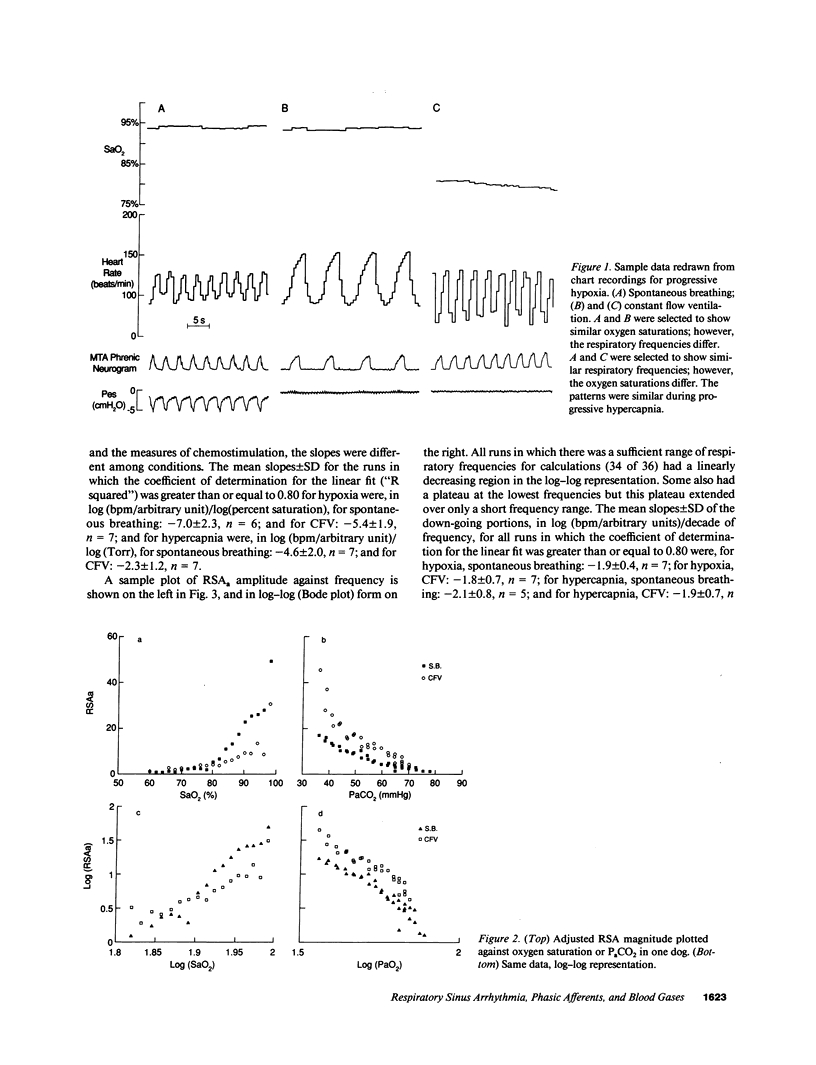
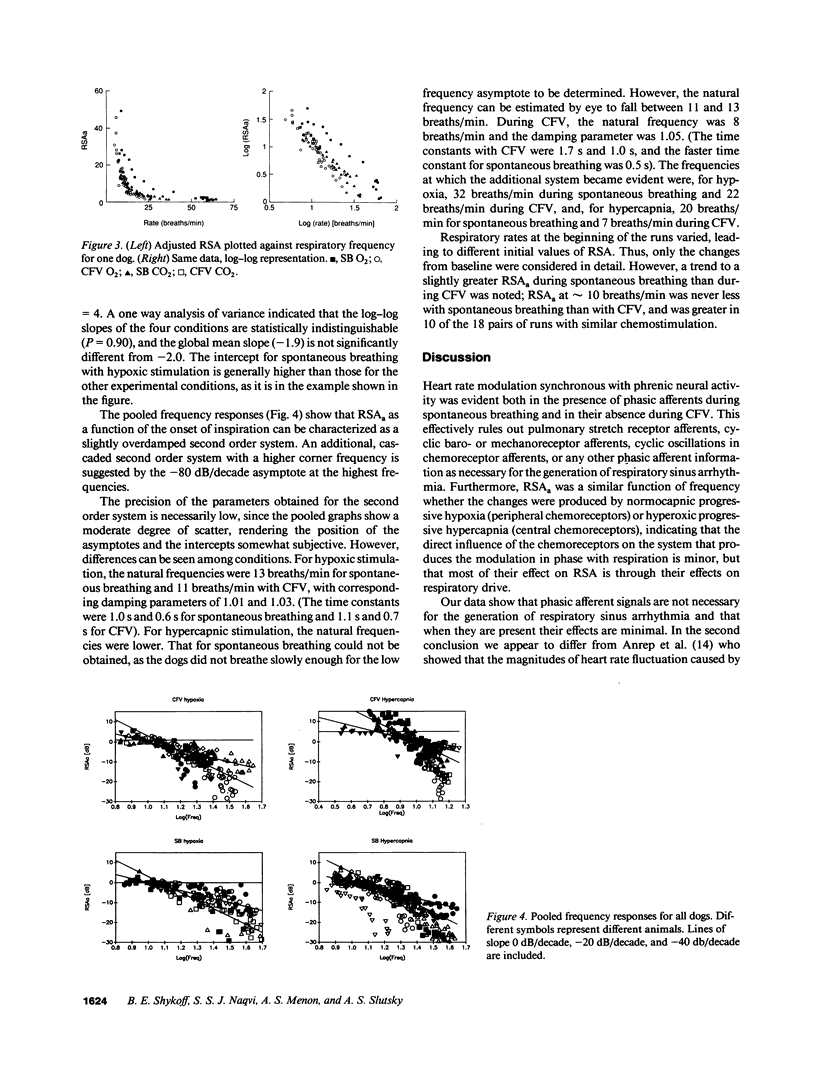
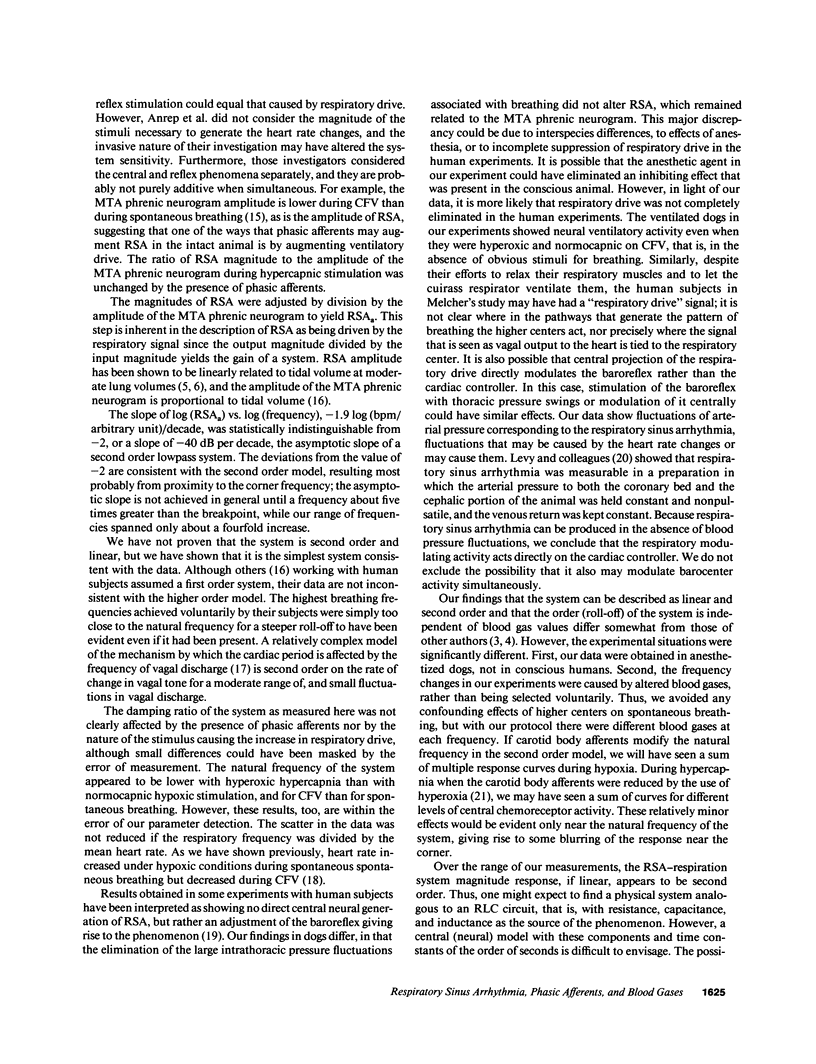

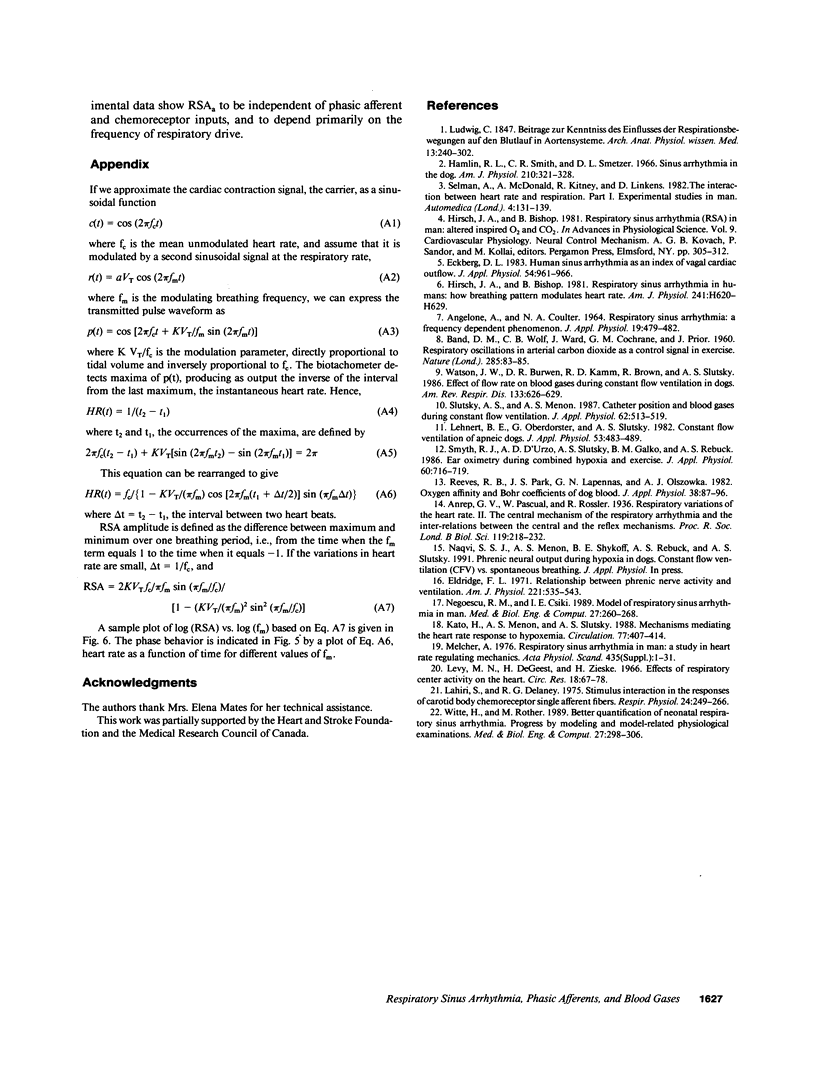
Selected References
These references are in PubMed. This may not be the complete list of references from this article.
- ANGELONE A., COULTER N. A., Jr RESPIRATORY SINUS ARRHYTHEMIA: A FREQUENCY DEPENDENT PHENOMENON. J Appl Physiol. 1964 May;19:479–482. doi: 10.1152/jappl.1964.19.3.479. [DOI] [PubMed] [Google Scholar]
- Eckberg D. L. Human sinus arrhythmia as an index of vagal cardiac outflow. J Appl Physiol Respir Environ Exerc Physiol. 1983 Apr;54(4):961–966. doi: 10.1152/jappl.1983.54.4.961. [DOI] [PubMed] [Google Scholar]
- Eldridge F. L. Relationship between phrenic nerve activity and ventilation. Am J Physiol. 1971 Aug;221(2):535–543. doi: 10.1152/ajplegacy.1971.221.2.535. [DOI] [PubMed] [Google Scholar]
- Hamlin R. L., Smith C. R., Smetzer D. L. Sinus arrhythmia in the dog. Am J Physiol. 1966 Feb;210(2):321–328. doi: 10.1152/ajplegacy.1966.210.2.321. [DOI] [PubMed] [Google Scholar]
- Hirsch J. A., Bishop B. Respiratory sinus arrhythmia in humans: how breathing pattern modulates heart rate. Am J Physiol. 1981 Oct;241(4):H620–H629. doi: 10.1152/ajpheart.1981.241.4.H620. [DOI] [PubMed] [Google Scholar]
- Kato H., Menon A. S., Slutsky A. S. Mechanisms mediating the heart rate response to hypoxemia. Circulation. 1988 Feb;77(2):407–414. doi: 10.1161/01.cir.77.2.407. [DOI] [PubMed] [Google Scholar]
- Lahiri S., DeLaney R. G. Stimulus interaction in the responses of carotid body chemoreceptor single afferent fibers. Respir Physiol. 1975 Sep;24(3):249–266. doi: 10.1016/0034-5687(75)90017-1. [DOI] [PubMed] [Google Scholar]
- Lehnert B. E., Oberdörster G., Slutsky A. S. Constant-flow ventilation of apneic dogs. J Appl Physiol Respir Environ Exerc Physiol. 1982 Aug;53(2):483–489. doi: 10.1152/jappl.1982.53.2.483. [DOI] [PubMed] [Google Scholar]
- Levy M. N., DeGeest H., Zieske H. Effects of respiratory center activity on the heart. Circ Res. 1966 Jan;18(1):67–78. doi: 10.1161/01.res.18.1.67. [DOI] [PubMed] [Google Scholar]
- Melcher A. Respiratory sinus arrhythmia in man. A study in heart rate regulating mechanisms. Acta Physiol Scand Suppl. 1976;435:1–31. [PubMed] [Google Scholar]
- Negoescu R. M., Csiki I. E. Model of respiratory sinus arrhythmia in man. Med Biol Eng Comput. 1989 May;27(3):260–268. doi: 10.1007/BF02441483. [DOI] [PubMed] [Google Scholar]
- Reeves R. B., Park J. S., Lapennas G. N., Olszowka A. J. Oxygen affinity and Bohr coefficients of dog blood. J Appl Physiol Respir Environ Exerc Physiol. 1982 Jul;53(1):87–95. doi: 10.1152/jappl.1982.53.1.87. [DOI] [PubMed] [Google Scholar]
- Slutsky A. S., Menon A. S. Catheter position and blood gases during constant-flow ventilation. J Appl Physiol (1985) 1987 Feb;62(2):513–519. doi: 10.1152/jappl.1987.62.2.513. [DOI] [PubMed] [Google Scholar]
- Smyth R. J., D'Urzo A. D., Slutsky A. S., Galko B. M., Rebuck A. S. Ear oximetry during combined hypoxia and exercise. J Appl Physiol (1985) 1986 Feb;60(2):716–719. doi: 10.1152/jappl.1986.60.2.716. [DOI] [PubMed] [Google Scholar]
- Watson J. W., Burwen D. R., Kamm R. D., Brown R., Slutsky A. S. Effect of flow rate on blood gases during constant flow ventilation in dogs. Am Rev Respir Dis. 1986 Apr;133(4):626–629. doi: 10.1164/arrd.1986.133.4.626. [DOI] [PubMed] [Google Scholar]
- Witte H., Rother M. Better quantification of neonatal respiratory sinus arrhythmia--progress by modelling and model-related physiological examinations. Med Biol Eng Comput. 1989 May;27(3):298–306. doi: 10.1007/BF02441489. [DOI] [PubMed] [Google Scholar]


